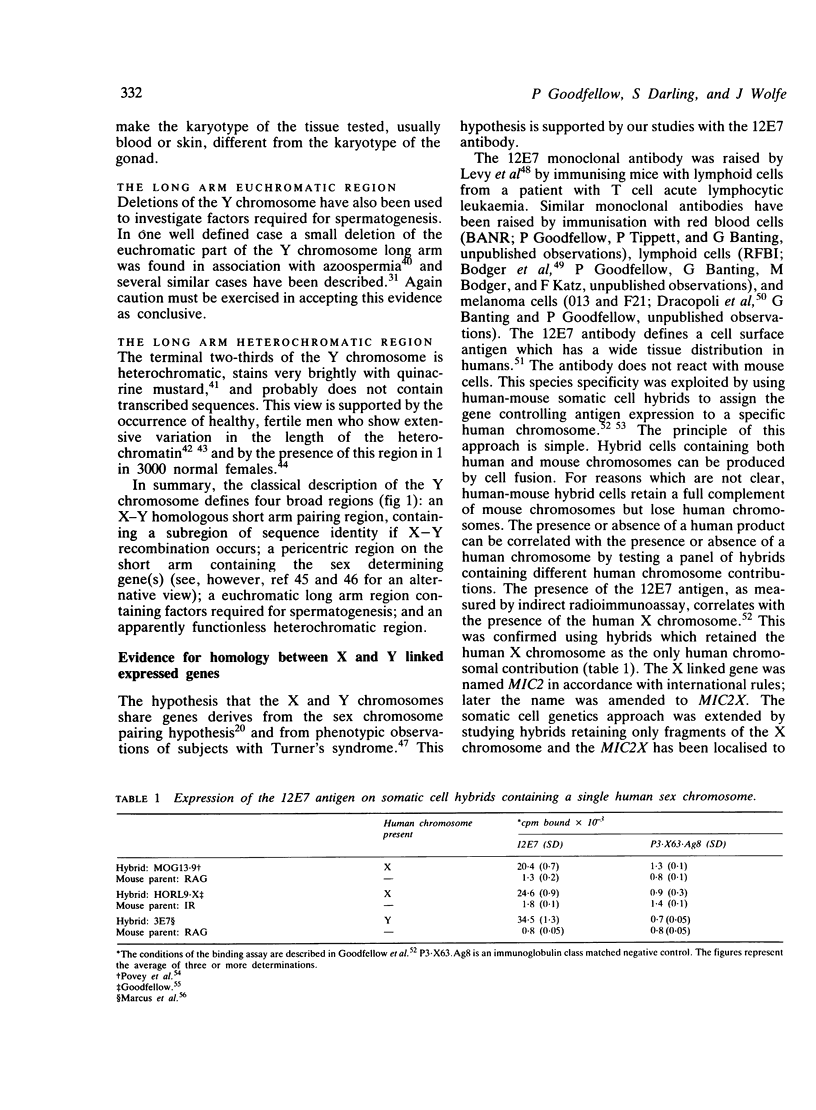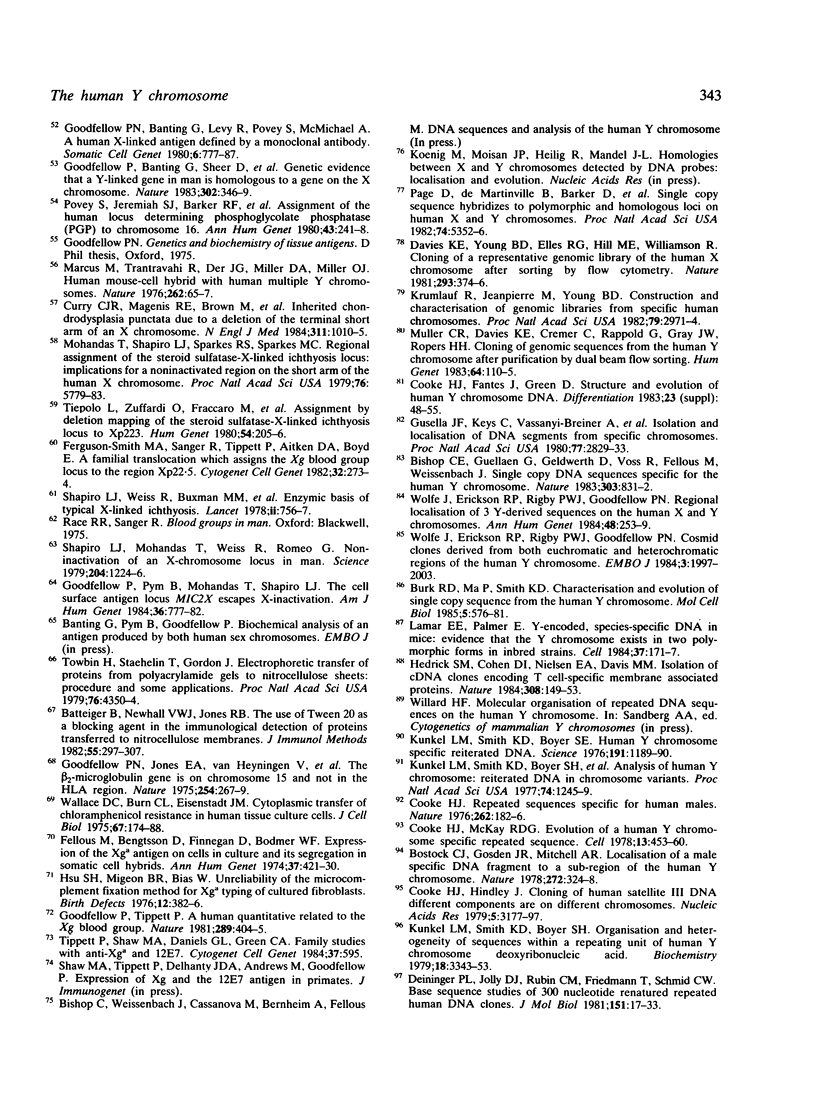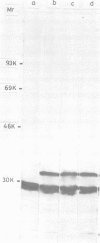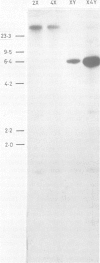Abstract
Despite its central role in sex determination, genetic analysis of the Y chromosome has been slow. This poor progress has been due to the paucity of available genetic markers. Whereas the X chromosome is known to include at least 100 functional genetic loci, only three or four loci have been ascribed to the Y chromosome and even the existence of several of these loci is controversial. Other factors limiting genetic analysis are the small size of the Y chromosome, which makes cytogenetic definition difficult, and the absence of extensive recombination. Based on cytogenetic observation and speculation, a working model of the Y chromosome has been proposed. In this classical model the Y chromosome is defined into subregions; an X-Y homologous meiotic pairing region encompassing most of the Y chromosome short arm and, perhaps, including a pseudoautosomal region of sex chromosome exchange; a pericentric region containing the sex determining gene or genes; and a long arm heterochromatic genetically inert region. The classical model has been supported by studies on the MIC2 loci, which encode a cell surface antigen defined by the monoclonal antibody 12E7. The X linked locus MIC2X, which escapes X inactivation, maps to the tip of the X chromosome short arm and the homologous locus MIC2Y maps to the Y chromosome short arm; in both cases, these loci are within the proposed meiotic pairing region. MIC2Y is the first biochemically defined, expressed locus to be found on the human Y chromosome. The proposed simplicity of the classical model has been challenged by recent molecular analysis of the Y chromosome. Using cloned probes, several groups have shown that a major part of the Y chromosome short arm is unlikely to be homologous to the X chromosome short arm. A substantial block of sequences of the short arm are homologous to sequences of the X chromosome long arm but well outside the pairing region. In addition, the short arm contains sequences shared with the Y chromosome long arm and sequences shared with autosomes. About two-thirds of XX males contain detectable Y derived sequences. As the amount of Y sequences present varies in different XX males, DNA from these subjects can be used to construct a map of the region around the sex determining gene. Assuming that XX males are usually caused by simple translocation, the sex determining genes cannot be located in the pericentric region. Although conventional genetic analysis of the Y chromosome is difficult, this chromosome is particularly suited to molecular analysis. Paradoxically, the Y chromosome may soon become the best defined human chromosome at the molecular level and may become the model for other chromosomes.
Full text
PDF















Images in this article
Selected References
These references are in PubMed. This may not be the complete list of references from this article.
- Ashley T. Nonhomologous synapsis of the sex chromosomes in the heteromorphic bivalents of two X-7 translocations in male mice: R5 and R6. Chromosoma. 1983;88(3):178–183. doi: 10.1007/BF00285617. [DOI] [PubMed] [Google Scholar]
- BARR M. L., SHAVER E. L., CARR D. H., PLUNKETT E. R. An unusual sex chromatin pattern in three mentally deficient subjects. J Ment Defic Res. 1959 Dec;3:78–87. doi: 10.1111/j.1365-2788.1959.tb00921.x. [DOI] [PubMed] [Google Scholar]
- Baker B. S., Belote J. M. Sex determination and dosage compensation in Drosophila melanogaster. Annu Rev Genet. 1983;17:345–393. doi: 10.1146/annurev.ge.17.120183.002021. [DOI] [PubMed] [Google Scholar]
- Bartels D., Thompson R. D. The characterization of cDNA clones coding for wheat storage proteins. Nucleic Acids Res. 1983 May 25;11(10):2961–2977. doi: 10.1093/nar/11.10.2961. [DOI] [PMC free article] [PubMed] [Google Scholar]
- Batteiger B., Newhall W. J., 5th, Jones R. B. The use of Tween 20 as a blocking agent in the immunological detection of proteins transferred to nitrocellulose membranes. J Immunol Methods. 1982 Dec 30;55(3):297–307. doi: 10.1016/0022-1759(82)90089-8. [DOI] [PubMed] [Google Scholar]
- Bishop C. E., Guellaen G., Geldwerth D., Voss R., Fellous M., Weissenbach J. Single-copy DNA sequences specific for the human Y chromosome. Nature. 1983 Jun 30;303(5920):831–832. doi: 10.1038/303831a0. [DOI] [PubMed] [Google Scholar]
- Bishop C., Guellaen G., Geldwerth D., Fellous M., Weissenbach J. Extensive sequence homologies between Y and other human chromosomes. J Mol Biol. 1984 Mar 15;173(4):403–417. doi: 10.1016/0022-2836(84)90388-7. [DOI] [PubMed] [Google Scholar]
- Bobrow M., Pearson P. L., Pike M. C., el-Alfi O. S. Length variation in the quinacrine-binding segment of human Y chromosomes of different sizes. Cytogenetics. 1971;10(3):190–198. doi: 10.1159/000130138. [DOI] [PubMed] [Google Scholar]
- Bodger M. P., Francis G. E., Delia D., Granger S. M., Janossy G. A monoclonal antibody specific for immature human hemopoietic cells and T lineage cells. J Immunol. 1981 Dec;127(6):2269–2274. [PubMed] [Google Scholar]
- Bostock C. J., Gosden J. R., Mitchell A. R. Localisation of a male-specific DNA fragment to a sub-region of the human Y chromosome. Nature. 1978 Mar 23;272(5651):324–328. doi: 10.1038/272324a0. [DOI] [PubMed] [Google Scholar]
- Burgoyne P. S. Genetic homology and crossing over in the X and Y chromosomes of Mammals. Hum Genet. 1982;61(2):85–90. doi: 10.1007/BF00274192. [DOI] [PubMed] [Google Scholar]
- Burk R. D., Ma P., Smith K. D. Characterization and evolution of a single-copy sequence from the human Y chromosome. Mol Cell Biol. 1985 Mar;5(3):576–581. doi: 10.1128/mcb.5.3.576. [DOI] [PMC free article] [PubMed] [Google Scholar]
- Bühler E. M. A synopsis of the human Y chromosome. Hum Genet. 1980;55(2):145–175. doi: 10.1007/BF00291764. [DOI] [PubMed] [Google Scholar]
- Cattanach B. M., Evans E. P., Burtenshaw M. D., Barlow J. Male, female and intersex development in mice of identical chromosome constitution. Nature. 1982 Dec 2;300(5891):445–446. doi: 10.1038/300445a0. [DOI] [PubMed] [Google Scholar]
- Cattanach B. M., Pollard C. E., Hawker S. G. Sex-reversed mice: XX and XO males. Cytogenetics. 1971;10(5):318–337. doi: 10.1159/000130151. [DOI] [PubMed] [Google Scholar]
- Chandley A. C., Goetz P., Hargreave T. B., Joseph A. M., Speed R. M. On the nature and extent of XY pairing at meiotic prophase in man. Cytogenet Cell Genet. 1984;38(4):241–247. doi: 10.1159/000132070. [DOI] [PubMed] [Google Scholar]
- Chandra H. S. Sex determination: a hypothesis based on noncoding DNA. Proc Natl Acad Sci U S A. 1985 Feb;82(4):1165–1169. doi: 10.1073/pnas.82.4.1165. [DOI] [PMC free article] [PubMed] [Google Scholar]
- Chapelle A. D., Schröder J., Murros J., Tallqvist G. Two XX males in one family and additional observations bearing on the etiology of XX males. Clin Genet. 1977 Feb;11(2):91–106. doi: 10.1111/j.1399-0004.1977.tb01285.x. [DOI] [PubMed] [Google Scholar]
- Chen A. T., Falek A. Cytological evidence for the association of the short arms of the X and Y chromosomes in the human male. Nature. 1971 Aug 20;232(5312):555–556. doi: 10.1038/232555a0. [DOI] [PubMed] [Google Scholar]
- Cooke H. J., Brown W. A., Rappold G. A. Closely related sequences on human X and Y chromosomes outside the pairing region. Nature. 1984 Sep 20;311(5983):259–261. doi: 10.1038/311259a0. [DOI] [PubMed] [Google Scholar]
- Cooke H. J., Hindley J. Cloning of human satellite III DNA: different components are on different chromosomes. Nucleic Acids Res. 1979 Jul 25;6(10):3177–3197. doi: 10.1093/nar/6.10.3177. [DOI] [PMC free article] [PubMed] [Google Scholar]
- Cooke H. J., McKay R. D. Evolution of a human Y chromosome-specific repeated sequence. Cell. 1978 Mar;13(3):453–460. doi: 10.1016/0092-8674(78)90319-7. [DOI] [PubMed] [Google Scholar]
- Cooke H. J., Noel B. Confirmation of Y/autosome translocation using recombinant DNA. Hum Genet. 1979;50(1):39–44. doi: 10.1007/BF00295587. [DOI] [PubMed] [Google Scholar]
- Cooke H. J., Schmidtke J., Gosden J. R. Characterisation of a human Y chromosome repeated sequence and related sequences in higher primates. Chromosoma. 1982;87(5):491–502. doi: 10.1007/BF00333470. [DOI] [PubMed] [Google Scholar]
- Cooke H. Repeated sequence specific to human males. Nature. 1976 Jul 15;262(5565):182–186. doi: 10.1038/262182a0. [DOI] [PubMed] [Google Scholar]
- Curry C. J., Magenis R. E., Brown M., Lanman J. T., Jr, Tsai J., O'Lague P., Goodfellow P., Mohandas T., Bergner E. A., Shapiro L. J. Inherited chondrodysplasia punctata due to a deletion of the terminal short arm of an X chromosome. N Engl J Med. 1984 Oct 18;311(16):1010–1015. doi: 10.1056/NEJM198410183111603. [DOI] [PubMed] [Google Scholar]
- Daiger S. P., Wildin R. S., Su T. S. Sequences on the human Y chromosome homologous to the autosomal gene for argininosuccinate synthetase. Nature. 1982 Aug 12;298(5875):682–684. doi: 10.1038/298682a0. [DOI] [PubMed] [Google Scholar]
- Davies K. E. Molecular genetics of the human X chromosome. J Med Genet. 1985 Aug;22(4):243–249. doi: 10.1136/jmg.22.4.243. [DOI] [PMC free article] [PubMed] [Google Scholar]
- Davies K. E., Young B. D., Elles R. G., Hill M. E., Williamson R. Cloning of a representative genomic library of the human X chromosome after sorting by flow cytometry. Nature. 1981 Oct 1;293(5831):374–376. doi: 10.1038/293374a0. [DOI] [PubMed] [Google Scholar]
- Davis R. M. Localisation of male determining factors in man: a thorough review of structural anomalies of the Y chromosome. J Med Genet. 1981 Jun;18(3):161–195. doi: 10.1136/jmg.18.3.161. [DOI] [PMC free article] [PubMed] [Google Scholar]
- Deininger P. L., Jolly D. J., Rubin C. M., Friedmann T., Schmid C. W. Base sequence studies of 300 nucleotide renatured repeated human DNA clones. J Mol Biol. 1981 Sep 5;151(1):17–33. doi: 10.1016/0022-2836(81)90219-9. [DOI] [PubMed] [Google Scholar]
- Dosik H., Wachtei S. S., Khan F., Spergel G., Koo G. C. Y-chromosomal genes in a phenotypic male with a 46XX karyotype. JAMA. 1976 Nov 29;236(22):2505–2508. [PubMed] [Google Scholar]
- Eichwald E. J., Silmser C. R. Skin. Transplant Bull. 1955;2:148–149. [PubMed] [Google Scholar]
- Evans E. P., Burtenshaw M. D., Cattanach B. M. Meitoic crossing-over between the X and Y chromosomes of male mice carrying the sex-reversing (Sxr) factor. Nature. 1982 Dec 2;300(5891):443–445. doi: 10.1038/300443a0. [DOI] [PubMed] [Google Scholar]
- Evans H. J., Buckton K. E., Spowart G., Carothers A. D. Heteromorphic X chromosomes in 46,XX males: evidence for the involvement of X-Y interchange. Hum Genet. 1979 May 23;49(1):11–31. doi: 10.1007/BF00277683. [DOI] [PubMed] [Google Scholar]
- FORD C. E., JONES K. W., POLANI P. E., DE ALMEIDA J. C., BRIGGS J. H. A sex-chromosome anomaly in a case of gonadal dysgenesis (Turner's syndrome). Lancet. 1959 Apr 4;1(7075):711–713. doi: 10.1016/s0140-6736(59)91893-8. [DOI] [PubMed] [Google Scholar]
- FRACCARO M., KAIJSER K., LINDSTEN J. A child with 49 chromosomes. Lancet. 1960 Oct 22;2(7156):899–902. doi: 10.1016/s0140-6736(60)91963-2. [DOI] [PubMed] [Google Scholar]
- Fantes J. A., Green D. K., Cooke H. J. Purifying human Y chromosomes by flow cytometry and sorting. Cytometry. 1983 Jul;4(1):88–91. doi: 10.1002/cyto.990040113. [DOI] [PubMed] [Google Scholar]
- Fellous M., Bengtsson B., Finnegan D., Bodmer W. F. Expression of the Xga antigen on cells in culture and its segregation in somatic cell hybrids. Ann Hum Genet. 1974 May;37(4):421–430. doi: 10.1111/j.1469-1809.1974.tb01847.x. [DOI] [PubMed] [Google Scholar]
- Ferguson-Smith M. A. X-Y chromosomal interchange in the aetiology of true hermaphroditism and of XX Klinefelter's syndrome. Lancet. 1966 Aug 27;2(7461):475–476. doi: 10.1016/s0140-6736(66)92778-4. [DOI] [PubMed] [Google Scholar]
- Freytag S. O., Bock H. G., Beaudet A. L., O'Brien W. E. Molecular structures of human argininosuccinate synthetase pseudogenes. Evolutionary and mechanistic implications. J Biol Chem. 1984 Mar 10;259(5):3160–3166. [PubMed] [Google Scholar]
- Frommer M., Prosser J., Vincent P. C. Human satellite I sequences include a male specific 2.47 kb tandemly repeated unit containing one Alu family member per repeat. Nucleic Acids Res. 1984 Mar 26;12(6):2887–2900. doi: 10.1093/nar/12.6.2887. [DOI] [PMC free article] [PubMed] [Google Scholar]
- Goldberg E. H., Boyse E. A., Bennett D., Scheid M., Carswell E. A. Serological demonstration of H-Y (male) antigen on mouse sperm. Nature. 1971 Aug 13;232(5311):478–480. doi: 10.1038/232478a0. [DOI] [PubMed] [Google Scholar]
- Goodfellow P. N., Andrews P. W. Sexual differentiation and h-y antigen. Nature. 1982 Jan 7;295(5844):11–13. doi: 10.1038/295011a0. [DOI] [PubMed] [Google Scholar]
- Goodfellow P. N., Jones E. A., Van Heyningen V., Solomon E., Bobrow M., Miggiano V., Bodmer W. F. The beta2-microglobulin gene is on chromosome 15 and not in the HL-A region. Nature. 1975 Mar 20;254(5497):267–269. doi: 10.1038/254267a0. [DOI] [PubMed] [Google Scholar]
- Goodfellow P. N., Tippett P. A human quantitative polymorphism related to Xg blood groups. Nature. 1981 Jan 29;289(5796):404–405. doi: 10.1038/289404a0. [DOI] [PubMed] [Google Scholar]
- Goodfellow P., Banting G., Levy R., Povey S., McMichael A. A human X-linked antigen defined by a monoclonal antibody. Somatic Cell Genet. 1980 Nov;6(6):777–787. doi: 10.1007/BF01538976. [DOI] [PubMed] [Google Scholar]
- Goodfellow P., Banting G., Sheer D., Ropers H. H., Caine A., Ferguson-Smith M. A., Povey S., Voss R. Genetic evidence that a Y-linked gene in man is homologous to a gene on the X chromosome. Nature. 1983 Mar 24;302(5906):346–349. doi: 10.1038/302346a0. [DOI] [PubMed] [Google Scholar]
- Goodfellow P., Pym B., Mohandas T., Shapiro L. J. The cell surface antigen locus, MIC2X, escapes X-inactivation. Am J Hum Genet. 1984 Jul;36(4):777–782. [PMC free article] [PubMed] [Google Scholar]
- Gordon J. W., Ruddle F. H. Mammalian gonadal determination and gametogenesis. Science. 1981 Mar 20;211(4488):1265–1271. doi: 10.1126/science.6259727. [DOI] [PubMed] [Google Scholar]
- Goulmy E., Bradley B. A., Lansbergen Q., van Rood J. J. The importance of H-Y incompatibility in human organ transplantation. Transplantation. 1978 Jun;25(6):315–319. doi: 10.1097/00007890-197806000-00007. [DOI] [PubMed] [Google Scholar]
- Goulmy E., Termijtelen A., Bradley B. A., van Rood J. J. Y-antigen killing by T cells of women is restricted by HLA. Nature. 1977 Apr 7;266(5602):544–545. doi: 10.1038/266544a0. [DOI] [PubMed] [Google Scholar]
- Guellaen G., Casanova M., Bishop C., Geldwerth D., Andre G., Fellous M., Weissenbach J. Human XX males with Y single-copy DNA fragments. Nature. 1984 Jan 12;307(5947):172–173. doi: 10.1038/307172a0. [DOI] [PubMed] [Google Scholar]
- Gusella J. F., Keys C., VarsanyiBreiner A., Kao F. T., Jones C., Puck T. T., Housman D. Isolation and localization of DNA segments from specific human chromosomes. Proc Natl Acad Sci U S A. 1980 May;77(5):2829–2833. doi: 10.1073/pnas.77.5.2829. [DOI] [PMC free article] [PubMed] [Google Scholar]
- Hedrick S. M., Cohen D. I., Nielsen E. A., Davis M. M. Isolation of cDNA clones encoding T cell-specific membrane-associated proteins. Nature. 1984 Mar 8;308(5955):149–153. doi: 10.1038/308149a0. [DOI] [PubMed] [Google Scholar]
- Heilig R., Hanauer A., Grzeschik K. H., Hors-Cayla M. C., Mandel J. L. Actin-like sequences are present on human X and Y chromosomes. EMBO J. 1984 Aug;3(8):1803–1807. doi: 10.1002/j.1460-2075.1984.tb02049.x. [DOI] [PMC free article] [PubMed] [Google Scholar]
- Hsu S. H., Migeon B. R., Bias W. B. Unreliability of the microcomplement fixation method for Xga typing of cultured fibroblasts. Birth Defects Orig Artic Ser. 1976;12(7):382–386. [PubMed] [Google Scholar]
- Hultén M. Chiasma distribution at diakinesis in the normal human male. Hereditas. 1974;76(1):55–78. doi: 10.1111/j.1601-5223.1974.tb01177.x. [DOI] [PubMed] [Google Scholar]
- JACOBS P. A., STRONG J. A. A case of human intersexuality having a possible XXY sex-determining mechanism. Nature. 1959 Jan 31;183(4657):302–303. doi: 10.1038/183302a0. [DOI] [PubMed] [Google Scholar]
- Jost A., Vigier B., Prépin J., Perchellet J. P. Studies on sex differentiation in mammals. Recent Prog Horm Res. 1973;29:1–41. doi: 10.1016/b978-0-12-571129-6.50004-x. [DOI] [PubMed] [Google Scholar]
- Keitges E., Rivest M., Siniscalco M., Gartler S. M. X-linkage of steroid sulphatase in the mouse is evidence for a functional Y-linked allele. Nature. 1985 May 16;315(6016):226–227. doi: 10.1038/315226a0. [DOI] [PubMed] [Google Scholar]
- Koenig M., Camerino G., Heilig R., Mandel J. L. A DNA fragment from the human X chromosome short arm which detects a partially homologous sequence on the Y chromosomes long arm. Nucleic Acids Res. 1984 May 25;12(10):4097–4109. doi: 10.1093/nar/12.10.4097. [DOI] [PMC free article] [PubMed] [Google Scholar]
- Krumlauf R., Jeanpierre M., Young B. D. Construction and characterization of genomic libraries from specific human chromosomes. Proc Natl Acad Sci U S A. 1982 May;79(9):2971–2975. doi: 10.1073/pnas.79.9.2971. [DOI] [PMC free article] [PubMed] [Google Scholar]
- Kunkel L. M., Smith K. D., Boyer S. H., Borgaonkar D. S., Wachtel S. S., Miller O. J., Breg W. R., Jones H. W., Jr, Rary J. M. Analysis of human Y-chromosome-specific reiterated DNA in chromosome variants. Proc Natl Acad Sci U S A. 1977 Mar;74(3):1245–1249. doi: 10.1073/pnas.74.3.1245. [DOI] [PMC free article] [PubMed] [Google Scholar]
- Kunkel L. M., Smith K. D., Boyer S. H. Human Y-chromosome-specific reiterated DNA. Science. 1976 Mar 19;191(4232):1189–1190. doi: 10.1126/science.1257744. [DOI] [PubMed] [Google Scholar]
- Kunkel L. M., Smith K. D., Boyer S. H. Organization and heterogeneity of sequences within a repeating unit of human Y chromosome deoxyribonucleic acid. Biochemistry. 1979 Jul 24;18(15):3343–3353. doi: 10.1021/bi00582a022. [DOI] [PubMed] [Google Scholar]
- Lamar E. E., Palmer E. Y-encoded, species-specific DNA in mice: evidence that the Y chromosome exists in two polymorphic forms in inbred strains. Cell. 1984 May;37(1):171–177. doi: 10.1016/0092-8674(84)90312-x. [DOI] [PubMed] [Google Scholar]
- Levy R., Dilley J., Fox R. I., Warnke R. A human thymus-leukemia antigen defined by hybridoma monoclonal antibodies. Proc Natl Acad Sci U S A. 1979 Dec;76(12):6552–6556. doi: 10.1073/pnas.76.12.6552. [DOI] [PMC free article] [PubMed] [Google Scholar]
- Madan K. Chromosome measurements on an XXp+ male. Hum Genet. 1976 May 19;32(2):141–142. doi: 10.1007/BF00291496. [DOI] [PubMed] [Google Scholar]
- Magenis R. E., Webb M. J., McKean R. S., Tomar D., Allen L. J., Kammer H., Van Dyke D. L., Lovrien E. Translocation(X;Y)(p22.33;p11.2) in XX males: etiology of male phenotype. Hum Genet. 1982;62(3):271–276. doi: 10.1007/BF00333535. [DOI] [PubMed] [Google Scholar]
- Manuelidis L. Chromosomal localization of complex and simple repeated human DNAs. Chromosoma. 1978 Mar 22;66(1):23–32. doi: 10.1007/BF00285813. [DOI] [PubMed] [Google Scholar]
- Manuelidis L. Repeating restriction fragments of human DNA. Nucleic Acids Res. 1976 Nov;3(11):3063–3076. doi: 10.1093/nar/3.11.3063. [DOI] [PMC free article] [PubMed] [Google Scholar]
- Marcus M., Tantravahi R., Dev V. G., Miller D. A., Miller O. J. Human-mouse cell hybrid with human multiple Y chromosomes. Nature. 1976 Jul 1;262(5563):63–65. doi: 10.1038/262063a0. [DOI] [PubMed] [Google Scholar]
- McKay R. D., Bobrow M., Cooke H. J. The identification of a repeated DNA sequence involved in the karyotype polymorphism of the human Y chromosome. Cytogenet Cell Genet. 1978;21(1-2):19–32. doi: 10.1159/000130875. [DOI] [PubMed] [Google Scholar]
- McLaren A., Monk M. Fertile females produced by inactivation of an X chromosome of "sex-reversed' mice. Nature. 1982 Dec 2;300(5891):446–448. doi: 10.1038/300446a0. [DOI] [PubMed] [Google Scholar]
- McLaren A., Simpson E., Tomonari K., Chandler P., Hogg H. Male sexual differentiation in mice lacking H-Y antigen. Nature. 1984 Dec 6;312(5994):552–555. doi: 10.1038/312552a0. [DOI] [PubMed] [Google Scholar]
- Mendelsohn M. L., Mayall B. H., Bogart E., Moore D. H., 2nd, Perry B. H. DNA content and DNA-based centromeric index of the 24 human chromosomes. Science. 1973 Mar 16;179(4078):1126–1129. doi: 10.1126/science.179.4078.1126. [DOI] [PubMed] [Google Scholar]
- Miller O. J., Drayna D., Goodfellow P. Report of the Committee on the Genetic Constitution of the X and Y Chromosomes. Cytogenet Cell Genet. 1984;37(1-4):176–204. doi: 10.1159/000132009. [DOI] [PubMed] [Google Scholar]
- Mohandas T., Shapiro L. J., Sparkes R. S., Sparkes M. C. Regional assignment of the steroid sulfatase-X-linked ichthyosis locus: implications for a noninactivated region on the short arm of human X chromosome. Proc Natl Acad Sci U S A. 1979 Nov;76(11):5779–5783. doi: 10.1073/pnas.76.11.5779. [DOI] [PMC free article] [PubMed] [Google Scholar]
- Moses M. J., Counce S. J., Paulson D. F. Synaptonemal complex complement of man in spreads of spermatocytes, with details of the sex chromosome pair. Science. 1975 Jan 31;187(4174):363–365. [PubMed] [Google Scholar]
- Müller C. R., Davies K. E., Cremer C., Rappold G., Gray J. W., Ropers H. H. Cloning of genomic sequences from the human Y chromosome after purification by dual beam flow sorting. Hum Genet. 1983;64(2):110–115. doi: 10.1007/BF00327104. [DOI] [PubMed] [Google Scholar]
- Page D. C., Harper M. E., Love J., Botstein D. Occurrence of a transposition from the X-chromosome long arm to the Y-chromosome short arm during human evolution. Nature. 1984 Sep 13;311(5982):119–123. doi: 10.1038/311119a0. [DOI] [PubMed] [Google Scholar]
- Page D. C., de la Chapelle A., Weissenbach J. Chromosome Y-specific DNA in related human XX males. Nature. 1985 May 16;315(6016):224–226. doi: 10.1038/315224a0. [DOI] [PubMed] [Google Scholar]
- Pearson P. L., Bobrow M. Definitive evidence for the short arm of the Y chromosome associating with the X chromosome during miosis in the human male. Nature. 1970 Jun 6;226(5249):959–961. doi: 10.1038/226959a0. [DOI] [PubMed] [Google Scholar]
- Phillips S. J., Birkenmeier E. H., Callahan R., Eicher E. M. Male and female mouse DNAs can be discriminated using retroviral probes. Nature. 1982 May 20;297(5863):241–243. doi: 10.1038/297241a0. [DOI] [PubMed] [Google Scholar]
- Povey S., Jeremiah S. J., Barker R. F., Hopkinson D. A., Robson E. B., Cook P. J., Solomon E., Bobrow M., Carritt B., Buckton K. E. Assignment of the human locus determining phosphoglycolate phosphatase (PGP) to chromosome 16. Ann Hum Genet. 1980 Jan;43(3):241–248. doi: 10.1111/j.1469-1809.1980.tb01557.x. [DOI] [PubMed] [Google Scholar]
- Rappold G. A., Cremer T., Cremer C., Back W., Bogenberger J., Cooke H. J. Chromosome assignment of two cloned DNA probes hybridizing predominantly to human sex chromosomes. Hum Genet. 1984;65(3):257–261. doi: 10.1007/BF00286513. [DOI] [PubMed] [Google Scholar]
- Rasmussen S. W., Holm P. B. Mechanics of meiosis. Hereditas. 1980;93(2):187–216. doi: 10.1111/j.1601-5223.1980.tb01360.x. [DOI] [PubMed] [Google Scholar]
- Shapiro L. J., Mohandas T., Weiss R., Romeo G. Non-inactivation of an x-chromosome locus in man. Science. 1979 Jun 15;204(4398):1224–1226. doi: 10.1126/science.156396. [DOI] [PubMed] [Google Scholar]
- Shapiro L. J., Weiss R., Buxman M. M., Vidgoff J., Dimond R. L., Roller J. A., Wells R. S. Enzymatic basis of typical X-linked icthyosis. Lancet. 1978 Oct 7;2(8093):756–757. doi: 10.1016/s0140-6736(78)92646-6. [DOI] [PubMed] [Google Scholar]
- Silvers W. K., Gasser D. L., Eicher E. M. H-Y antigen, serologically detectable male antigen and sex determination. Cell. 1982 Mar;28(3):439–440. doi: 10.1016/0092-8674(82)90197-0. [DOI] [PubMed] [Google Scholar]
- Singer M. F. Highly repeated sequences in mammalian genomes. Int Rev Cytol. 1982;76:67–112. doi: 10.1016/s0074-7696(08)61789-1. [DOI] [PubMed] [Google Scholar]
- Singh L., Jones K. W. Sex reversal in the mouse (Mus musculus) is caused by a recurrent nonreciprocal crossover involving the x and an aberrant y chromosome. Cell. 1982 Feb;28(2):205–216. doi: 10.1016/0092-8674(82)90338-5. [DOI] [PubMed] [Google Scholar]
- Solari A. J. Synaptosomal complexes and associated structures in microspread human spermatocytes. Chromosoma. 1980;81(3):315–337. doi: 10.1007/BF00368145. [DOI] [PubMed] [Google Scholar]
- Solari A. J. The behavior of the XY pair in mammals. Int Rev Cytol. 1974;38(0):273–317. doi: 10.1016/s0074-7696(08)60928-6. [DOI] [PubMed] [Google Scholar]
- Tiepolo L., Zuffardi O., Fraccaro M., di Natale D., Gargantini L., Müller C. R., Ropers H. H. Assignment by deletion mapping of the steroid sulfatase X-linked ichthyosis locus to Xp223. Hum Genet. 1980;54(2):205–206. doi: 10.1007/BF00278973. [DOI] [PubMed] [Google Scholar]
- Tiepolo L., Zuffardi O. Localization of factors controlling spermatogenesis in the nonfluorescent portion of the human Y chromosome long arm. Hum Genet. 1976 Oct 28;34(2):119–124. doi: 10.1007/BF00278879. [DOI] [PubMed] [Google Scholar]
- Towbin H., Staehelin T., Gordon J. Electrophoretic transfer of proteins from polyacrylamide gels to nitrocellulose sheets: procedure and some applications. Proc Natl Acad Sci U S A. 1979 Sep;76(9):4350–4354. doi: 10.1073/pnas.76.9.4350. [DOI] [PMC free article] [PubMed] [Google Scholar]
- Wallace D. C., Bunn C. L., Eisenstadt J. M. Cytoplasmic transfer of chloramphenicol resistance in human tissue culture cells. J Cell Biol. 1975 Oct;67(1):174–188. doi: 10.1083/jcb.67.1.174. [DOI] [PMC free article] [PubMed] [Google Scholar]
- Willard H. F., Smith K. D., Sutherland J. Isolation and characterization of a major tandem repeat family from the human X chromosome. Nucleic Acids Res. 1983 Apr 11;11(7):2017–2033. doi: 10.1093/nar/11.7.2017. [DOI] [PMC free article] [PubMed] [Google Scholar]
- Wolfe J., Darling S. M., Erickson R. P., Craig I. W., Buckle V. J., Rigby P. W., Willard H. F., Goodfellow P. N. Isolation and characterization of an alphoid centromeric repeat family from the human Y chromosome. J Mol Biol. 1985 Apr 20;182(4):477–485. doi: 10.1016/0022-2836(85)90234-7. [DOI] [PubMed] [Google Scholar]
- Wolfe J., Erickson R. P., Rigby P. W., Goodfellow P. N. Cosmid clones derived from both euchromatic and heterochromatic regions of the human Y chromosome. EMBO J. 1984 Sep;3(9):1997–2003. doi: 10.1002/j.1460-2075.1984.tb02081.x. [DOI] [PMC free article] [PubMed] [Google Scholar]
- Wolfe J., Erickson R. P., Rigby P. W., Goodfellow P. N. Regional localization of 3 Y-derived sequences on the human X and Y chromosomes. Ann Hum Genet. 1984 Jul;48(Pt 3):253–259. doi: 10.1111/j.1469-1809.1984.tb01022.x. [DOI] [PubMed] [Google Scholar]
- Yang T. P., Hansen S. K., Oishi K. K., Ryder O. A., Hamkalo B. A. Characterization of a cloned repetitive DNA sequence concentrated on the human X chromosome. Proc Natl Acad Sci U S A. 1982 Nov;79(21):6593–6597. doi: 10.1073/pnas.79.21.6593. [DOI] [PMC free article] [PubMed] [Google Scholar]
- de la Chapelle A., Simola K., Simola P., Knuutila S., Gahmberg N., Pajunen L., Lundqvist C., Sarna S., Murros J. Heteromorphic X chromosomes in 46,XX males? Hum Genet. 1979 Nov;52(2):157–167. doi: 10.1007/BF00271568. [DOI] [PubMed] [Google Scholar]
- de la Chapelle A. The etiology of maleness in XX men. Hum Genet. 1981;58(1):105–116. doi: 10.1007/BF00284157. [DOI] [PubMed] [Google Scholar]
- de la Chapelle A., Tippett P. A., Wetterstrand G., Page D. Genetic evidence of X-Y interchange in a human XX male. Nature. 1984 Jan 12;307(5947):170–171. doi: 10.1038/307170a0. [DOI] [PubMed] [Google Scholar]




